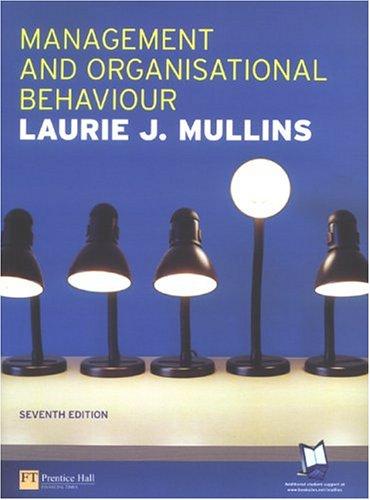In business organisations, as elsewhere, success tends to breed success. However, a growing sense of corporate self-confidence
Question:
In business organisations, as elsewhere, success tends to breed success. However, a growing sense of corporate self-confidence can breed problems of its own. How does a company prevent pride in its achievements (especially through sustained growth in profitability and customer retention) from degenerating into complacency and stagnation so that, in effect, success breeds failure? Few people have more cause to dwell on this issue than Michael Smith, the Chief Executive of Sisson Systems. Sisson is a hugely successful and professionally run business with operations in many fields, such as retailing, information technology, facilities management, and financial services. Much of Sisson's growth has been fuelled by acquisitions;
however, it has achieved at least 20 per cent growth rate in each of the last 15 years. It has an enviable reputation for both quality and service; surveys show that its various customer groups are delighted with much of what Sisson does for them.
Michael Smith became Chief Executive at Sisson about six months ago. It was his first appointment at this level, and he is anxious to build on the progress made in the past and, if possible, achieve even more. He would like Sisson Systems to be viewed as a 'benchmark' for service standards, product innovation, customer ratings, and employee commitment; to this end he is supported by a broadly compatible group of Directors on the Sisson board, who have appointed Smith in the expectation of continued improvement.
On the other hand, the success of Sisson Systems may itself be eroding the effort of some of the company's senior executives. 'In organisations that are successful, people begin to believe that the reason they are successful is them', says Michael. Indeed, it would be natural for each of the company's divisional managing directors - each with their own strengths and weaknesses - to begin to think that their style was the reason for their division's performance.
Eventually, Sisson Systems could break down into a collection of separate power groups, each with its distinctive sub-culture. If this were to happen, reasons Michael, then the added-value from the overall image of Sisson Systems would be lost.
Michael believes in 'one culture, one organisation', and as a result is emphatically opposed to giving too much latitude to any part of the company.
He wants to sustain uniformity by finding the best (human resource) management practices through a process of evaluation, and imposing them on the Sisson Systems workforce as a whole. Of course, he concedes that this concern for centralised control is unfashionable, but he is able to point to the track record of the company as the ultimate justification for his approach.
Sisson Systems uses incentive schemes, share option opportunities and the like in order to stimulate managerial/executive performance. But, in Michael's view, reward itself can sometimes reduce the hunger for success. As people become older and more settled - Sisson Systems has many such people in senior roles, who have devoted the vast majority of their careers to the company - then they may lose their dynamism. 'In my own personal experience' says Michael, 'the most difficult people to motivate are well adjusted people. Someone who is happy is extremely difficult to motivate.'
Questions
Imagine that you are a management consultant who has been engaged by Michael Smith in order to address the human resource management issues which are currently on his mind. Write a report for Michael Smith in which you answer each of the following questions (posed by him):
(a) How may Sisson Systems continue to inspire and stimulate exceptional performance from managers and executives who, in Michael Smith's phrase, are 'well adjusted' and 'happy', but who may have become too complacent with the continued success of the company.
(b) How could the company identify and (humanely) release those employees who seem to have little left to contribute to the company.
(c) How can the company's human resource management policies and systems effectively maintain a balance between centralised corporate control and empowered divisional freedom.
Step by Step Answer:






